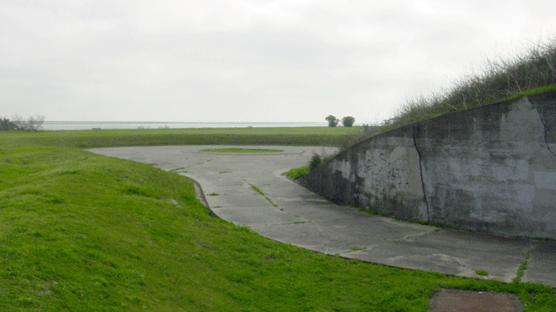U.S. Seacoast Defense 1781-1948: A Brief History
Plans and Projects Between the Wars, 1917-1940
The years after the turn of the century were very productive in the design and building of naval guns and gunnery. By 1915, several foreign battleships could outrange any harbor defense weapon in the United States. Moreover, the high firing angles of naval guns generally nullified the advantages of the disappearing carriages then used by the United States. During the war, guns were removed from the existing seacoast defenses and remounted for use overseas by coast artillery units. At home the coast artillery posts served as enlistment and training centers for those going overseas, as the danger of naval attack lessened. The U.S. Army entered a period of austerity following the end of the war in 1918. Many of the coast defense forts were put on caretaker status, maintained by a few soldiers and used as summer training camps for reserve, National Guard, Reserve Officers Training Corps (ROTC), and Civilian Military Training Corps (CMTC) units. New long-range 12-inch and 16-inch army ordnance for sea-coast armament was built, supplemented by 16-inch naval guns made available as the result of naval reductions due to the Washington Naval Treaty of 1922. New harbor defense construction plans were drawn up, but few new batteries were actually built during this period.

A post World War I era battery-the gun platform of Battery Kimble, Fort Travis, Galveston, TX
Mobile guns left over from the war were utilized as supplemental fire-power to support the older guns. 12-inch mortars and 8-inch guns and a few 14-inch guns on railroad carriages were stationed at defended harbors. During WWI, the United States had purchased from France a number of 155 mm GPF tractor-drawn guns, which were later made in the U.S. as the M1918. In the late 1920s, these were pressed into a coastal defense role. To increase the ussefulness of these guns, they were mounted on easily built concrete “Panama” mounts, named after the area where they were first built. The growing importance of aircraft as an offensive weapon resulted in the formation and training of specialized Coast Artillery Corps antiaircraft artillery units during this period. Antiaircraft guns were installed at harbor defense reservations during WWI and years thereafter.
Links to Other Periods
Civil War & Post-Civil War (1861-1875)
